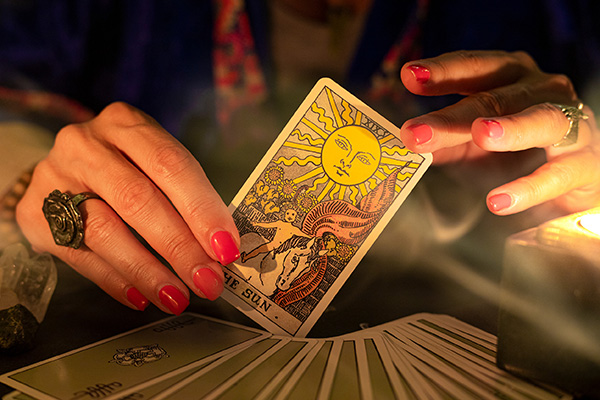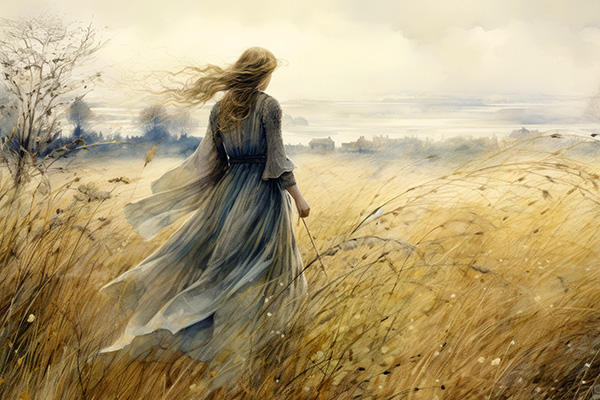Learning To Trust Your Inner Truth
 Have you ever noticed that whenever you’re really enjoying what you’re doing, it’s as if there’s an amazing energy flow or undercurrent carrying you along?
Have you ever noticed that whenever you’re really enjoying what you’re doing, it’s as if there’s an amazing energy flow or undercurrent carrying you along?
In these magical moments it feels as if the universe itself is moving with you, effortlessly aligning circumstances, people, and opportunities in your favor.
Don’t you wish you could live like this all the time? Imagine a life where every decision you make feels right, where your inner compass is so attuned to your truth that you rarely second-guess yourself.
Unfortunately, we too often worry about what others might think of us, or we choose the practical path – the road most traveled. We fall into the trap of following the opinions of others instead of tuning in and listening to our own inner guidance.
The fear of rejection or failure too often looms large, keeping us tethered to a path that feel safe but uninspiring. We convince ourselves that following our soul’s calling is a luxury rather than a necessity.
Following your inner truth is not selfish. Following the flow of what is true for you also doesn’t mean you’re shirking your responsibilities. It simply means that you are choosing, moment by moment, what feels right for your soul.
Society bombards us daily with standards and our families with expectations of what’s right and acceptable, yet how often do we stop and do a self-check-in? How often do we ask ourselves, “Is this really what I want?” instead of “Is this what I’m supposed to want?”
The Sacred Invitation Of A Spring Renewal
 With the first delicate buds unfurling and the air perfumed with the invigorating scent of nature’s reawakening, Spring has officially arrived. This sacred season carries with it the powerful energies of change, whispering to us of transformation, renewal and new beginnings.
With the first delicate buds unfurling and the air perfumed with the invigorating scent of nature’s reawakening, Spring has officially arrived. This sacred season carries with it the powerful energies of change, whispering to us of transformation, renewal and new beginnings.
But as exhilarating as change can be, it often comes with uncertainty, excitement, and sometimes even fear. We find ourselves at a crossroads between the comfort of the known and the vast potential of what lies ahead.
During the winter months, we instinctively retreated inward — both physically, as we sought warmth from the cold, and spiritually, as we turned our awareness inward to reflect, heal, and dream. Without even realizing it, we entered the sacred cave of our inner wisdom and nurtured the seeds of our soul’s deepest desires.
Now, as the earth awakens and the air becomes warmer, so does the essence of our being, ready to give birth to something new and profound.
Although you may not fully understand what is unfolding within you, your soul is always aware. It has been preparing you for this moment, nurturing the visions and intentions that you have been quietly cultivating in the silence of winter.
Sometimes new beginnings manifest as external changes — a career change, a move to a new home, or new relationships. Other times they unfold as inner changes — an awakening of self-love, a renewed sense of purpose, or a deepened spiritual connection.
The Multi-Layered Magic Of The Tarot
 It’s no secret that the Tarot is my favorite divination tool. It is like a trusted assistant to me, always there to provide support and clarity, both in my professional work and in my own spiritual practice.
It’s no secret that the Tarot is my favorite divination tool. It is like a trusted assistant to me, always there to provide support and clarity, both in my professional work and in my own spiritual practice.
Do you know how sometimes you have a gut feeling about something, but you can’t quite put it your finger on it? Or how sometimes you have trouble remembering someone’s name, even though it’s on the tip of your tongue?
Well, that’s how the Tarot helps me when I read for people. It often helps me bridge everyday life with the esoteric and translate psychic messages in a more practical way.
The cards act as a metaphysical magnifying glass, sharpening my psychic impressions and intuitions into clear messages, guidance and predictions. Sometimes it is just a single symbolic element in a card that jumps out, demanding attention and holding the key to unlocking the essence of the message.
A single Tarot card can reveal a plethora of meanings and insights, each layer shaped by that particular reading. Tarot is deeply symbolic and fluid, allowing each card to be interpreted in myriad ways.
First, the context of the reading is important. Whether the question is about love, career, health, finances, or personal fulfillment, the meaning of a card can change significantly. For example, the Two of Cups could mean a romantic partnership in a relationship reading, but a harmonious business partnership in a career reading.
Second, the client’s state of mind and personal circumstances influence the interpretation of the card. Their experiences, desires, and fears color how the imagery and symbolism will be perceived by the psychic. The same Two of Cups might highlight existing trust issues for one person, while signifying a newfound connection for another.
Keeping Shining Your Soul Light!
 We all have a soul light — a radiant energy within us that’s eternal and uniquely ours. It shines brightest when we’re true to ourselves. Each of us is different for a reason, and when we embrace that — especially when others might not understand — we tap into the magic of who we truly are.
We all have a soul light — a radiant energy within us that’s eternal and uniquely ours. It shines brightest when we’re true to ourselves. Each of us is different for a reason, and when we embrace that — especially when others might not understand — we tap into the magic of who we truly are.
When we compare ourselves to others, we lose sight of our own path. We can end up pretending to be someone we’re not, and that’s exhausting. It sets unrealistic expectations and keeps us from letting our true light shine.
Have you ever felt like you don’t fit in? Like you’re just… different? The first step to finding yourself is to step back from trying to fit into other people’s boxes. Sure, it can feel lonely at first, but if you stick with it and trust the process, you’ll find a confidence that’s unshakable. You’ll discover a self-esteem that allows your talents and gifts to flourish.
So many of us get caught up in worrying about what others think. This happens a lot in relationships, especially in the beginning. Maybe you’ve been there: You start dating someone, everything seems great, and then out of nowhere they stop texting or calling. Days go by, maybe even a week, and you wonder, “What did I do wrong?
Our first instinct is usually to blame ourselves. We overthink every little thing, digging up all our insecurities and past hurts. Sometimes it’s like a flood of old memories, bringing back childhood moments or difficult family dynamics. It’s draining, and honestly, it’s not helpful.
Releasing Resistance Transforms Your Life
 Many years ago I traveled to Sedona, Arizona to attend a teacher training program for The Sedona Method. Little did I know that I was about to discover one of the most important keys to a happy and fulfilling life.
Many years ago I traveled to Sedona, Arizona to attend a teacher training program for The Sedona Method. Little did I know that I was about to discover one of the most important keys to a happy and fulfilling life.
I soon found myself in a conference room filled with psychiatrists, psychologists, and doctors from all over the world. I was a young mother and an novice psychic reader. I didn’t feel on the same professional level as the doctors and behavioral health professionals in the room. I felt intimidated, uncomfortable, and wanted nothing more than to go home.
But within the first few days of training, my worst nightmare came true. The trainer asked me to come to the front of the room and stand facing everyone.
“Oh no,” I thought to myself. “Why in the world did I even come to this class?”
He asked me to demonstrate one of the resistance release techniques he had taught us to a psychiatrist sitting in the front row. My knees were shaking and my heart was racing. But there was no escape, so I decided to just do it. It was a terrifying experience at the time, but it was also one of the best things that ever happened to me!
The Sedona Method is a technique designed to help you release the resistance created by painful or unwanted emotions, allowing you to experience greater personal freedom and well-being. The method involves a series of questions that help you become aware of your feelings and gently encourage you to release them. Resistance is often the cause of suffering in relationships, financial health, career, and all other areas of life.
Inner Journey To The Mystical Isle Of Avalon
 Sometimes when the pressures and demands of modern life become too much, I retreat to one of my favorite places in the universe: the mythical island of Avalon.
Sometimes when the pressures and demands of modern life become too much, I retreat to one of my favorite places in the universe: the mythical island of Avalon.
This legendary island of Celtic mythology is steeped in legends of healing, psychic learning, sacred crafting, and the life and times of King Arthur. Its name translates as “Isle of Apples,” emphasizing its association with fertility, abundance, and otherworldly beauty.
In folklore, Avalon, or Insula Avallonis, was a sanctuary of deep spiritual and psychic knowledge and was known as a training ground for pagan priestesses dedicated to the Great Mother Goddess. These women dedicated their lives to spirituality, honing their skills in clairvoyance, herbalism, weaving, and deep devotion to the Divine Feminine.
But Avalon was not only a sanctuary for women. Men were also an integral part of its story. Merlin the magician is inextricably linked to the history of the island, having trained the young Arthur there for his kingship.
Avalon is also entwined with many other tales woven through the lives of King Arthur, Guinevere, Morgan le Fay, Merlin, Nimue (the Lady of the Lake), and others. Legend also has it that King Arthur was brought to Avalon by his half-sister, Morgan le Fay, to heal after being badly wounded in battle.
The question of whether Avalon really existed straddles the line between myth and reality. Some historians and researchers speculate that Avalon may be based on a real place. Glastonbury, England, is often associated with Avalon because of its mystical aura and ties to Arthurian legend.
The Deeper Truth And Wisdom Of Psychic Reading
 A good psychic reading offers more than just clarity and peace of mind — it is also a profound catalyst for spiritual growth.
A good psychic reading offers more than just clarity and peace of mind — it is also a profound catalyst for spiritual growth.
When you have a psychic reading, you and your psychic form a connection on a soul level. This connection feels almost like stepping into another dimension, as you both raise your vibration and access a higher state of consciousness.
This process is both fascinating and mysterious. Often spirit will guide you to a particular psychic, even if you’re not sure why you feel drawn to them. This inner pull is your natural guidance system at work, nudging you toward the person who can provide the insights you need.
The personal issue or life challenge that’s weighing on your mind — whether it’s love, career, business, health, family or friends — is often the key to unlocking a portal of understanding. This portal holds hidden treasures: the spiritual lessons and growth opportunities that await you.
Edgar Cayce, one of the most documented psychics in history, believed that the purpose of psychic readings, or what he called “life readings,” was to provide guidance and insight to help people on their personal and spiritual journeys. He emphasized that these readings provide invaluable information about one’s health and wellness, life purpose, and spiritual growth.
Cayce’s more than 14,000 documented psychic readings often focused on holistic health, addressing the physical, mental, and spiritual aspects of a person’s well-being. He also believed that everyone has the potential to access their own inner guidance and intuition, and that psychic readings could serve as a tool to help us tap into this inner wisdom.
